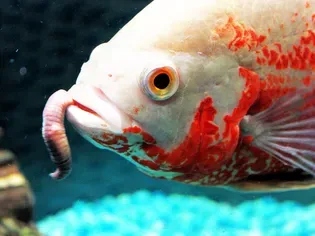Feeding Your Fish Live Food
Updated on 04/26/24

Feeding Your Fish Live Food: A Comprehensive Guide to Nutritional Enhancement
As a dedicated fish enthusiast, providing your aquatic companions with an optimal diet is paramount. Live food offers exceptional nutritional benefits that can enhance the health, vibrancy, and overall well-being of your fish. This comprehensive guide will delve into the advantages, considerations, and best practices associated with feeding your fish live food.
Nutritional Value of Live Food
Live food is a nutritional powerhouse, brimming with essential nutrients that are vital for fish health. These include:
- Protein: Live food is particularly rich in protein, which is indispensable for fish growth, muscle development, and tissue repair.
- Fat: Live food contains a balanced ratio of essential fatty acids, including omega-3 and omega-6, which are crucial for brain function, vision, and skin health.
- Vitamins: Live food is an abundant source of vitamins A, C, and E, which play key roles in immune function, antioxidant protection, and overall metabolism.
- Minerals: Live food is also a rich source of minerals, such as calcium, phosphorus, and magnesium, which are essential for bone development, enzyme function, and nerve transmission.
Benefits of Feeding Live Food
Incorporating live food into your fish's diet offers a multitude of benefits, including:
- Increased Digestion: The movement and wriggling of live food stimulates the fish's digestive system, improving their overall digestion and nutrient absorption.
- Exercise and Mental Stimulation: Hunting and chasing live food provides mental and physical exercise for fish, keeping them active and alert.
- Natural Behaviors: Feeding live food allows fish to engage in their natural foraging instincts, which can reduce stress and promote overall well-being.
- Enhanced Immune Function: The nutritional density of live food strengthens the fish's immune system, making them more resistant to diseases and infections.
Considerations for Feeding Live Food
Before introducing live food to your fish, it's crucial to consider the following factors:
- Size and Species: Choose live food that is appropriate for the size and species of your fish. Small fish, for example, require smaller live food, such as brine shrimp or daphnia.
- Health and Safety: Ensure that the live food you provide is healthy and free from parasites or diseases. It's advisable to purchase live food from reputable sources.
- Frequency: The frequency of feeding live food depends on the species of fish and its age. As a general rule, feed young fish more frequently than adult fish.
- Variety: Offer a variety of live food to ensure that your fish receive a balanced diet. Rotate between different types of worms, insects, and crustaceans.
Best Practices for Feeding Live Food
To maximize the benefits and minimize the risks associated with feeding live food, follow these best practices:
- Quarantine: Quarantine live food for a few days before introducing it to your main tank to prevent the transmission of diseases or parasites.
- Rinse: Rinse live food thoroughly with clean water to remove any debris or contaminants.
- Moderate Amount: Feed your fish a moderate amount of live food at a time to avoid overfeeding and water quality issues.
- Monitor Behavior: Observe your fish closely after feeding live food. Check for any signs of discomfort or digestive distress.
Examples
Here are some examples of common types of live food and their nutritional value:
- Brine Shrimp: Rich in protein, essential fatty acids, and vitamins. Suitable for small fish species.
- Daphnia: A small crustacean that is a good source of protein, minerals, and antioxidants. Suitable for small to medium-sized fish species.
- Blackworms: Segmented worms that are high in protein and fat. Suitable for carnivorous fish species.
- Mealworms: The larvae of darkling beetles, mealworms are a good source of protein, chitin, and minerals. Suitable for larger fish species.
- Crickets: Gut-loaded crickets are a nutritious treat for fish that provides a high amount of protein and calcium. Suitable for large carnivorous fish species.
Conclusion
Feeding your fish live food can significantly enhance their nutritional intake, boosting their health, vibrancy, and overall well-being. By considering the nutritional value, benefits, and considerations associated with live food, you can provide your aquatic companions with a well-rounded diet that supports their optimal growth and development. Remember to follow best practices for feeding live food to ensure the safety and well-being of your fish.
Explore More Pets

Freshwater Aquarium Filters
How to Deal With Cloudy Aquarium Water

Saltwater Aquarium Filters
How Do You Remove Chloramines From Tap Water?

Freshwater Aquariums & Habitat
Can I Keep My Koi Fish Inside?

Saltwater Aquariums & Habitat
14 Best Floating Plants for Your Aquarium

Freshwater Fish Health
How to Treat Ich on Freshwater Fish

Saltwater Fish Health
Fin Rot in Aquarium Fish

Freshwater Aquarium Filters
How to Do Aquarium Water Changes

Saltwater Fish Health
How Do Fish Get Parasites?